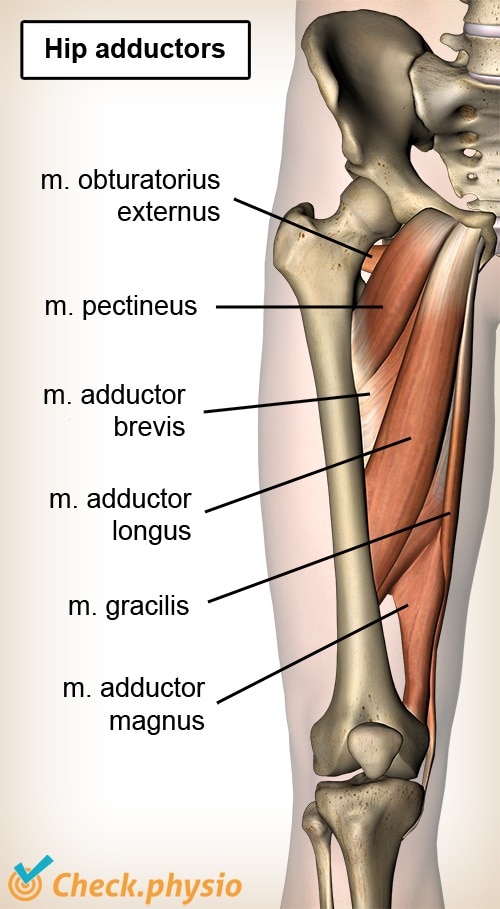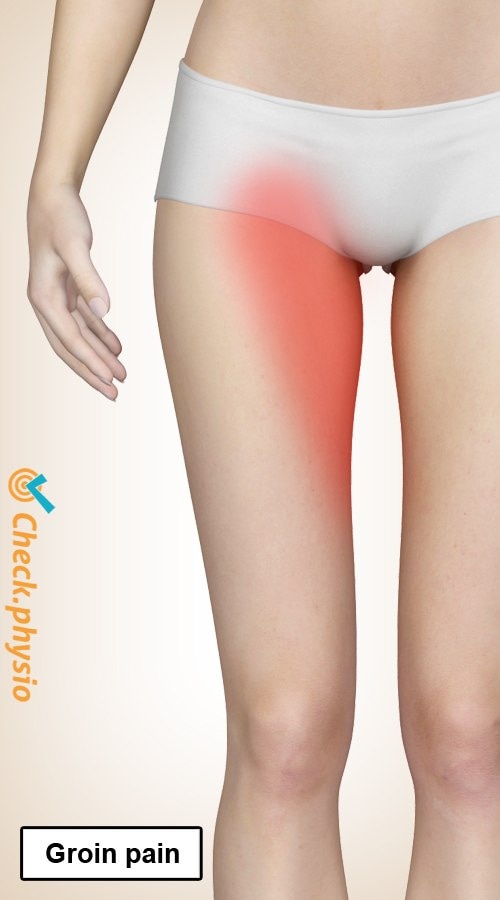Adduction-related groin pain
Groin injury
Groin pain is a common complaint amongst athletes. There are various causes. One common cause is an injury to the hip adductors. This is the group of muscles located on the inside of the thigh.

Injuries to the hip adductors are common in footballers and in sports such as running, volleyball, gymnastics, skating and dancing.
Description of the condition
The hip adductors are the muscles that move the thigh inwards (adduction). They are located on the inside of the thigh and originate from the hipbone (os coxae). The hip adductors are called the 'adductor brevis', 'adductor longus', 'adductor magnus', 'pectineus', 'gracilis' and 'obturatorius externus'. The adductor longus and the gracilis in particular are often affected in the case of a groin injury.
In the case of adduction-related groin pain there is usually a problem with the tendons of the muscles in the area where they attach to the hipbone, or the muscle-tendon junction. The tendon can be inflamed (tendinitis), deteriorate in quality and structure (tendinosis) or can be strained or torn (rupture). This causes symptoms in the groin region.
Cause and origin
The symptoms can develop either gradually or acutely. The acute form is associated with pain immediately after a person missteps or makes any other incorrect movement. If the symptoms develop gradually, they are often first noticeable after exercise. At a later stage the pain also occurs during exercise.
The exact cause of adduction-related groin pain is not known. It is thought that biomechanics abnormalities of the leg (e.g. foot position and difference in leg length), imbalance of the surrounding muscles of the hip and muscle fatigue all increase the risk of adductor injuries. Increased muscle tension (hypertonicity) of the hip adductors appears to be an important factor that results in chronic groin problems.
Signs & symptoms
- Pain on the inside of the thigh, in the groin region.
- Pressing on the adductors and their attachment point can provoke the pain.
- The pain often radiates along the inside of the thigh. Sometimes it even radiates to the lower abdomen or genitals.
- Inward movement of the leg increases the pain, particularly if this movement is forceful.
- Sometimes the patient will feel that their underwear is causing the symptoms.
- There is increased muscle tension in the thigh. This can cause a tight and hard feeling, particularly if the symptoms have existed for a longer period.
Diagnosis
Treatment
If the symptoms do not disappear on their own, the first important task is to determine the underlying cause of the symptoms. The physiotherapist can assist you in this. As soon as any tears have healed, the treatment consists of (eccentric) strength training of the hip adductors and a general exercise programme for the muscles of the buttocks, legs and trunk. In addition, stretching exercises and physiotherapeutic techniques can be applied.
Exercises
An exercise programme for adduction-related groin pain includes (eccentric) strengthening of the hip adductors, stretching exercises and a general exercise programme of the gluteal, leg and trunk muscles. See also exercises for adduction-related groin pain.
You can check your symptoms using the online physiotherapy check or make an appointment with a physiotherapy practice in your area.

References
Morelli, V. & Weaver, V. (2005). Groin injuries and groin pain in athletes: part 1. Prim Care Clin Office Pract. 2005;32:163-183.
Nugteren, K. van & Winkel, D. (2006). Onderzoek en behandeling van peesaandoeningen - tendinose. Houten: Bohn Stafleu van Loghum.
Stappen, B.W.J. van der (2011). Diagnostische tekens bij een chronische liesblessure. Physios. 2011 jul; editie 2.



